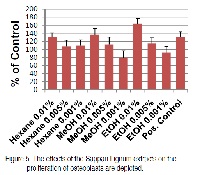The characterization and anti-osteoporotic activity of Sappan Lignum (Caesalpinia sappan L.) extracts
Keywords:
Caesalpinia sappan L., Sappan Lignum, characterization, anti-osteoporosisAbstract
The standardization and characterization of medicinal plants is important for establishing the scientific basis for the therapeutic effects of a traditional medicine. Sappan Lignum (Caesalpinia sappan L.) is a plant that is commonly used as a traditional medicine in Southeast Asia. In Indonesia, it is used to treat dysentery, hemoptysis, and ophthalmic diseases and as a depurative; the Buginese tribe add it to daily drinking water to prevent and treat osteoporosis. This study aimed to characterize the Caesalpinia sappan heartwood extracts and to evaluate the anti-osteoporosis activity of the characterized extracts to provide evidence for the efficacy of this traditional medicinal plant. The characterization was performed by chromatographic and spectrophotometric methods after treating the Sappan Lignum with n-hexane, methanol and 70% ethanol. Numerous high intensity peaks were detected on the spectrum from the methanol extract, indicating that the secondary metabolites of this plant were more soluble in methanol than in ethanol and n-hexane. The anti-osteoporosis activity was determined by evaluating the ability of the extracts to stimulate the proliferation of osteoblasts that were isolated from neonatal mouse calvaria and to inhibit the formation of osteoclast-like cells, which are responsible for bone absorption and resorption. The data revealed that all the extracts increased the proliferation of osteoblasts and inhibited the formation of osteoclast-like cells. In the osteoblasts, the ethanol extract was 64% more active than the untreated control and the other extracts at 100 µg/ml (0.01%). Compared with calcitonin, which was the positive control (2 U/ml), the extracts weakly inhibited the formation of osteoclast-like cells. Among the extracts, the ethanol extract most robustly stimulated the osteoblasts and inhibited the formation of osteoclast-like cells, suggesting that it has potential as a candidate anti-osteoporosis agent.
References
Orwa C, Mutua A, Kindt R, Jamnadass R, Simons A. Agroforestree database; a tree reference ad selection guide version 4.0. 2009 (http://worldagroforestry.org/af/treedb/).
. Nagai M, Nagumo S, Lee SM, Eguchi I, Kawai KI. Protosappanin A, a Novel Biphenyl coumpound from Sappan Lignum. Chem. Phar. Bull. 1986; 34: 1-6.
. Nguyen MT, Awale S, Tezuka Y, Tran QL, Kadota S. Xanthin oxidase inhibitors from heartwood of Vietnamese Caesalpinia sappan. Chem. Pharm. Bull. 2005; 53(8): 984-988.
. Wu YB, Wu JG, Yi J, Chen TQ, Lin XH, Wu JZ. Osteoblastic activity of ethanolic extract and volatile compounds from Er-Zhi-Wan, a famous traditional Chinese herbal Formula. Afr J Pharm and Pharmaco. 2012; 6(24): 1733-1740.
. Xu HX, Lee SF. The antibacterial principle of Caesalpinia sappan. Phytother Res. 2004; 18: 647-651.
. You EJ, Khil LY, Kwak WJ, Won HS, Chae SH, Lee BH, Moon CK. Effect of brazilin on the production of fructose-2-6-bisphosphate in rat hepatocytes. J Ethnopharmacol. 2005; 102: 53-57
. Badami S, Moorkoth S, Rai SR, Kannan E, Bhojraj S. Anti oxidant activity of caesalpinia sappan heartwood, Biol. Phar. Bull. 2003; 26: 1534-1537
. Baek NI, Jeon SG, Ahn EM, Hahn JT, Bahn JH, Jang JS, Cho SW, Park JK, Choi SY. Anti convulsant compounds from the wood of Caesalpinia sappan L. Arch Pharmaca. Res. 2000; 23: 344-348.
. Miller LG. Herbal medicinals. Arc. Intern. Med., 1998, 158, 2200−2211.
. Takahashi N, Akatsu T, Udagawa N, Sasaki K, Yamaguchi A, Mosley JM, Martin TJ, Suda T. Osteoblastic cells are involved in osteoclast formation. Endocrinology. 123: 2600-2602
. Wang D, Li F, Jiang Z. Osteoblastic stimulating activity of Proralea corylifolia extracts ant two of its flavanoids. Planta Med. 2001; 67: 748-749.
. Zhang DW, Cheng Y, Wang NL, Zhang JC, Yang MS, Yao XS. Effect of total flavanoids and flavonol glycosides from epimedium koreanum Nakai on the proliferation and differentiation of primary osteoblast. Phytomed. 2008; 15: 55-61.
. Han N, Huang T, Wang YC, Yin J, Kadota S. Flavanone glycosides from viscum coloratum and their inhibitory effect on octeoclast formation. Chemistry and biodiversity. 2011; 8: 1682-1688.
. Abdollahi M, Larijani B, Rahimi R, Salari P. Role of oxidative stress in osteoporosis. Therapy 2005; 2: 787-796.
. Pacifici R., Estrogen, cytokines, and pathogenesis of post menopausal osteoporosis. J. Bone Miner Res. 1996; 11: 1043-1051



